Watershed Management
The Air Force Academy landscape plays a critical role in maintaining the resilency 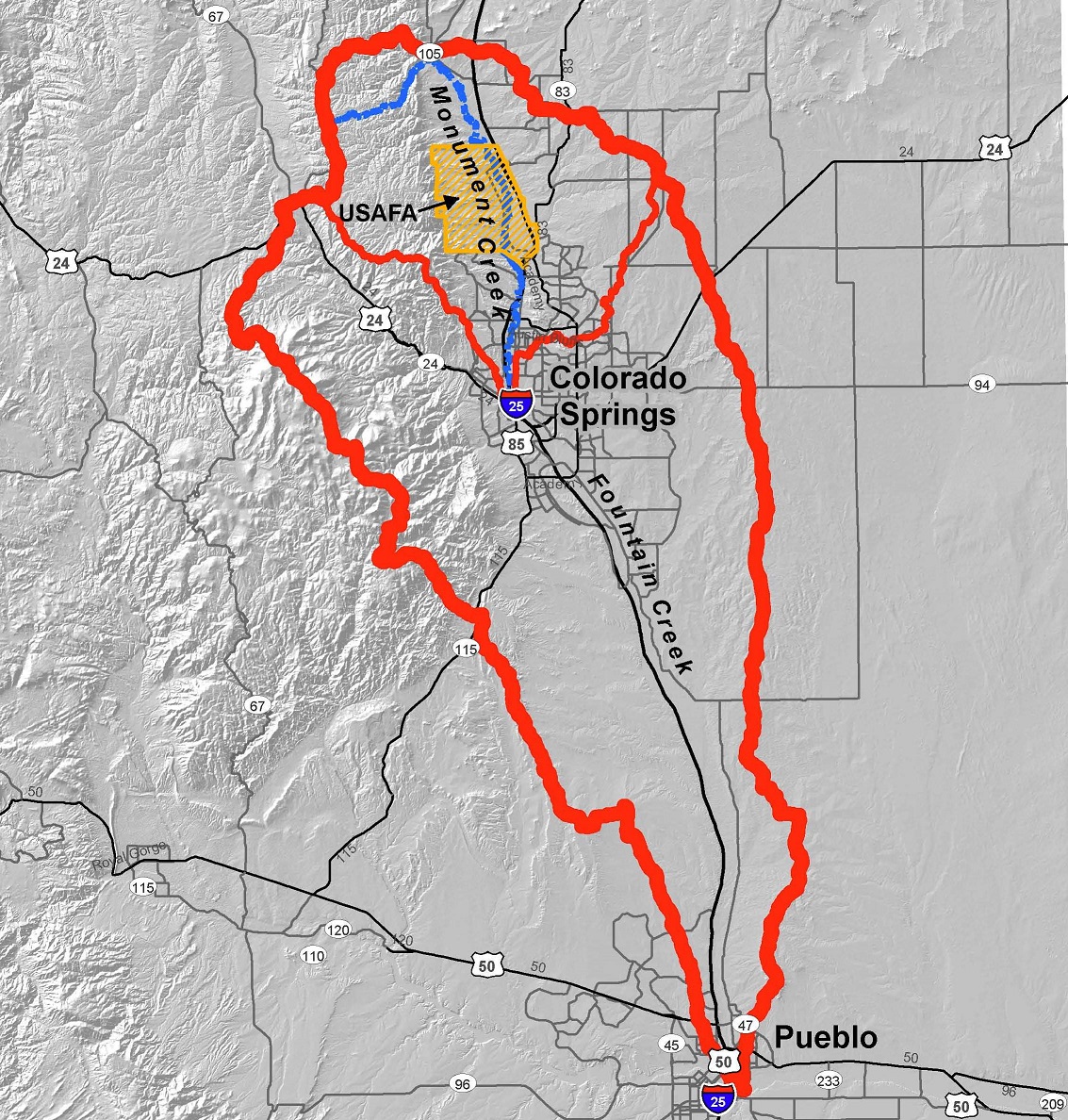 of the Monument Creek and Fountain Creek watersheds to regional flooding and urban stormwater drainage. The installation's 18,455 acres, including Monument Creek and its tributary streams, cover less than 12% of the Monument Creek watershed, but the Academy's central location and lower elevation in the landscape results in nearly 75% of the watershed's drainage area flowing through the base's creeks. Fortunately, many of the wetland and riparian systems still provide ecosystem services and values such as a diversity of wildlife habitat, improved water quality, enhanced water and sediment storage, and flood protection. Many streams and riparian areas, however, have been severely impacted by improperly managed stormwater and poor water quality (primarily sediment) originating from off-base development. Runoff from impervious surfaces in the Cadet Area, Community Center, and housing has also eroded streams and drainages, causing additional habitat loss and sedimentation.
of the Monument Creek and Fountain Creek watersheds to regional flooding and urban stormwater drainage. The installation's 18,455 acres, including Monument Creek and its tributary streams, cover less than 12% of the Monument Creek watershed, but the Academy's central location and lower elevation in the landscape results in nearly 75% of the watershed's drainage area flowing through the base's creeks. Fortunately, many of the wetland and riparian systems still provide ecosystem services and values such as a diversity of wildlife habitat, improved water quality, enhanced water and sediment storage, and flood protection. Many streams and riparian areas, however, have been severely impacted by improperly managed stormwater and poor water quality (primarily sediment) originating from off-base development. Runoff from impervious surfaces in the Cadet Area, Community Center, and housing has also eroded streams and drainages, causing additional habitat loss and sedimentation.
A healthy watershed, with proper functioning streams and riparian areas, provides valuable habitat for wildlife and enhances the scenic diversity and quality of the Air Force Academy's grounds. To help sustain these values, the Academy partners with various organizations, such as the Fountain Creek Watershed Flood Control and Greenway District (FCWFCGWD) and the City Stormwater Enterprise, to address regional drainage issues. In 2016, the Academy collaborated with the City of Colorado Springs, El Paso County, FCWFCGWD, and Colorado Springs Utilities to develop a Monument Creek Watershed Flood Restoration Master Plan. The plan identified areas of hydrologic, hydraulic, and geomorphic instability within the watershed, and prioritized land management and engineering projects to address significant erosion and sedimentation problems. Many of the recommended actions will mitigate the off-base and on-base stormwater impacts that are degrading the Academy's wetland and riparian habitat and threatenen the base's infrastructure.
The Colorado Natural Heritage Program prepared a Monument Creek Watershed Landscape Assessment in 2002.
Stream Stabilization and Habitat Restoration
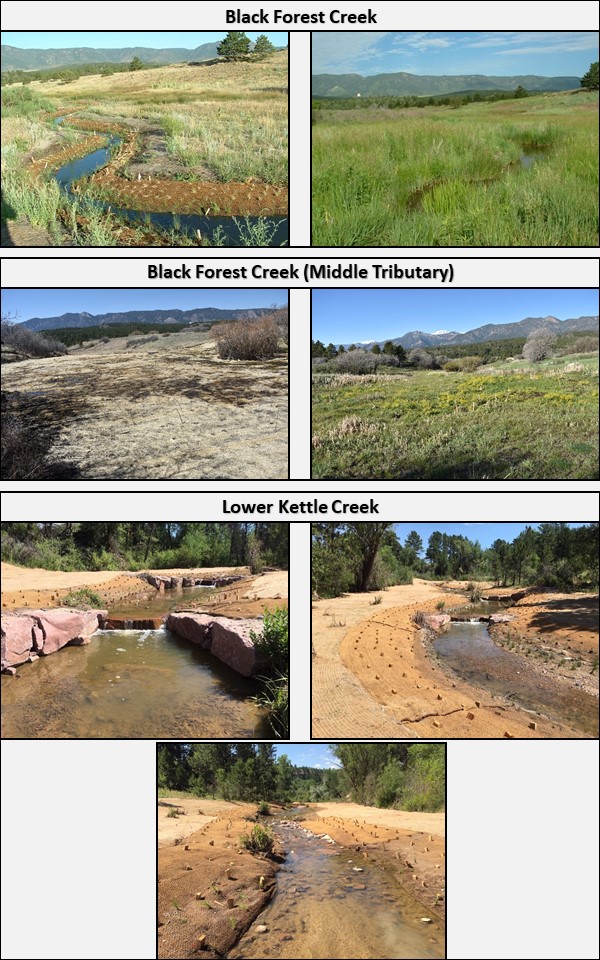
Stormwater Damage to Eastern Tributaries of Monument Creek
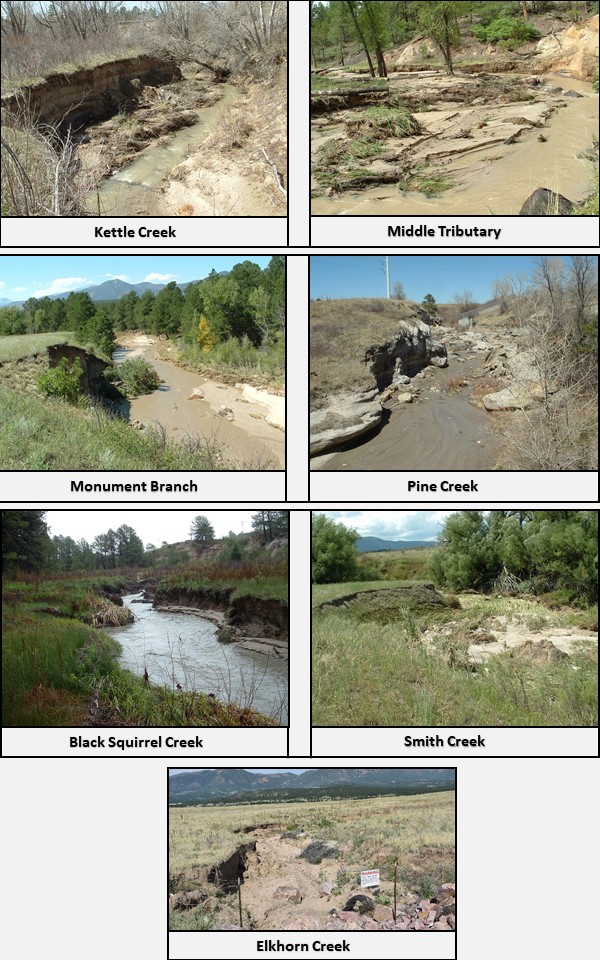
Noxious Weed Control
Noxious weeds are invasive, non-native plants that disrupt 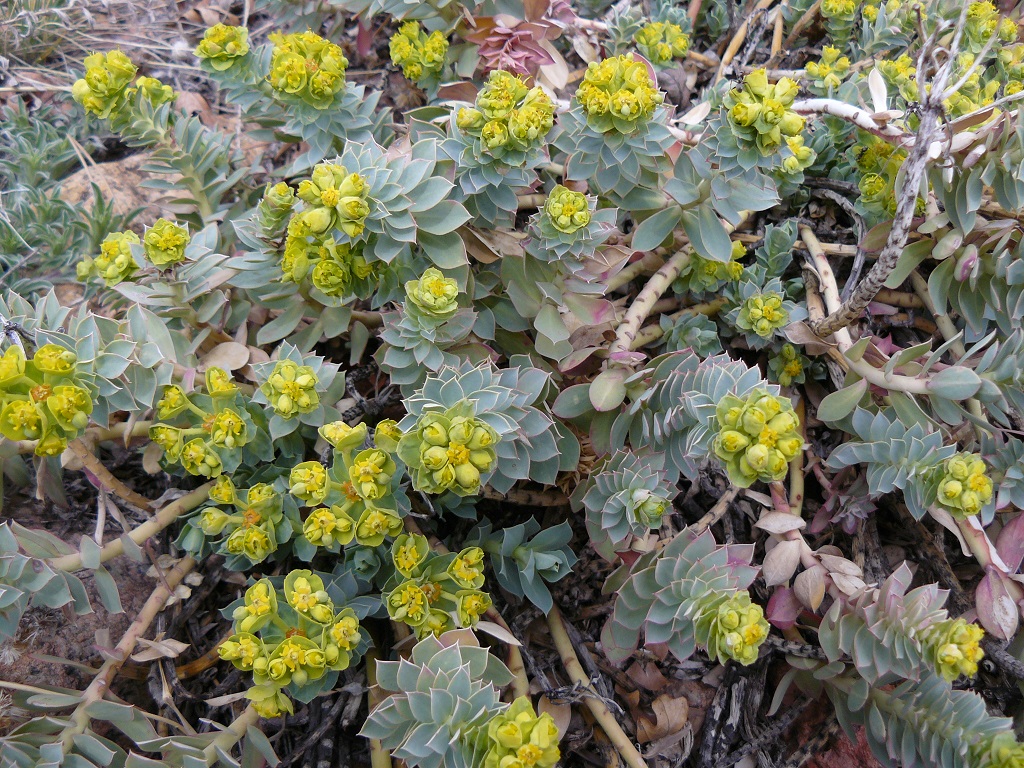 agricultural production and natural ecosystems, causing economic loss and environmental damage. Many of these plants originated from Europe, Asia, or Africa, and were introduced to the United States without the natural biological controls (often insects) that normally limit a population. Plants introduced to the U.S. by the floral, shipping, and landscaping industries have frequently escaped and established in native habitats. Introduced, non-native plants can out-compete native species by growing rapidly, producing large quantities of seed, establishing extensive root systems, or being unpalatable to grazing animals. Weeds can quickly invade an area when seeds or pieces of root are dispersed by wind, water, animals, and people.
agricultural production and natural ecosystems, causing economic loss and environmental damage. Many of these plants originated from Europe, Asia, or Africa, and were introduced to the United States without the natural biological controls (often insects) that normally limit a population. Plants introduced to the U.S. by the floral, shipping, and landscaping industries have frequently escaped and established in native habitats. Introduced, non-native plants can out-compete native species by growing rapidly, producing large quantities of seed, establishing extensive root systems, or being unpalatable to grazing animals. Weeds can quickly invade an area when seeds or pieces of root are dispersed by wind, water, animals, and people.
The Air Force Academy utilizes an Integrated Weed Management (IWM) approach to prevent noxious weeds from establishing, or to control weeds that already exist. IWM includes the use of cultural, mechanical, biological, chemical, and other preventative measures:
- Cultural - reseeding disturbed areas with native plants
- Mechanical - mowing, digging, pulling, removing seed heads
- Biological - using weed-specific insects, microbes, or pathogens to control seed production and plant growth
- Chemical - spraying weed-specific herbicides
- Preventative - requiring weed-free seed, hay, and mulch; cleaning equipment before moving to another site
Through annual monitoring and periodic surveys, Natural Resources evaluates the effectiveness of these measures for controlling noxious weeds. Monitoring and surveys also aid in the early detection and rapid response to help prevent small weed infestations from establishing and spreading. With over 25 noxious weed species known to occur on the intallation, including various thistles, knapweeds, spurges, and toadflax, management requires constant effort and vigilance. A complete list of noxious weeds is provided in the Integrated Noxious Weed Management Plan. With so many weeds to control on 19,000+ acres, control efforts are prioritized by considering the degree of ecological threat posed by the weed species and their occurrence in designated Special Weed Management Areas where important native plant communities, wildlife habitats, and rare species occur.
Erosion Control and Native Revegetation
Land stripped of native vegetation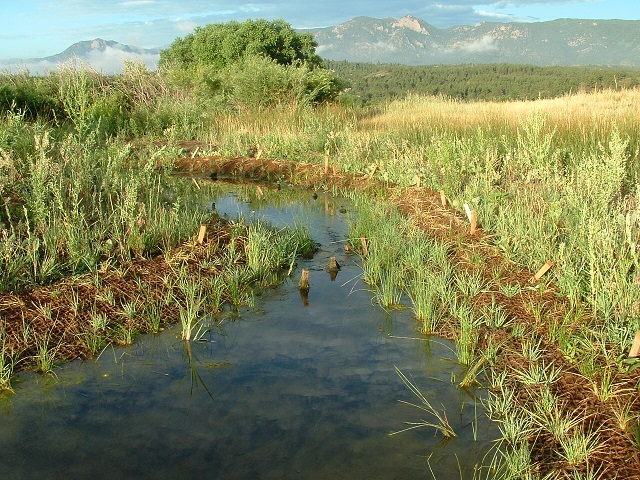 by flooding, grazing, construction, fire, or other means is highly susceptible to noxious weed invasion and soil erosion. Wildlife habitat values, watershed hydrology, and landscape aesthetics are also affected by the temporary or permanent loss of vegetation. To mitigate these impacts and protect the Academy's significant natural and cultural resources, the base requires all land restoration activities to utilize state-of-the-art revegetation and soil protection measures. This is accomplished through Revegetation and Erosion Control Standards which emphasize the use of native plants, quality topsoil, and biodegradable soil protection fabrics or mulches for restoration.
by flooding, grazing, construction, fire, or other means is highly susceptible to noxious weed invasion and soil erosion. Wildlife habitat values, watershed hydrology, and landscape aesthetics are also affected by the temporary or permanent loss of vegetation. To mitigate these impacts and protect the Academy's significant natural and cultural resources, the base requires all land restoration activities to utilize state-of-the-art revegetation and soil protection measures. This is accomplished through Revegetation and Erosion Control Standards which emphasize the use of native plants, quality topsoil, and biodegradable soil protection fabrics or mulches for restoration.